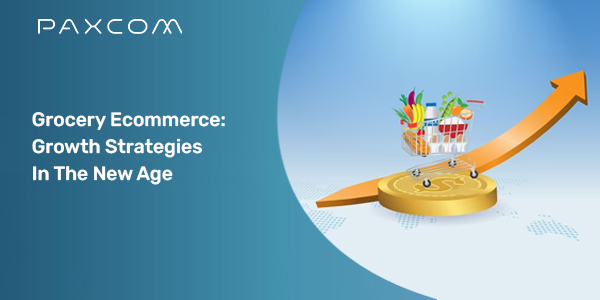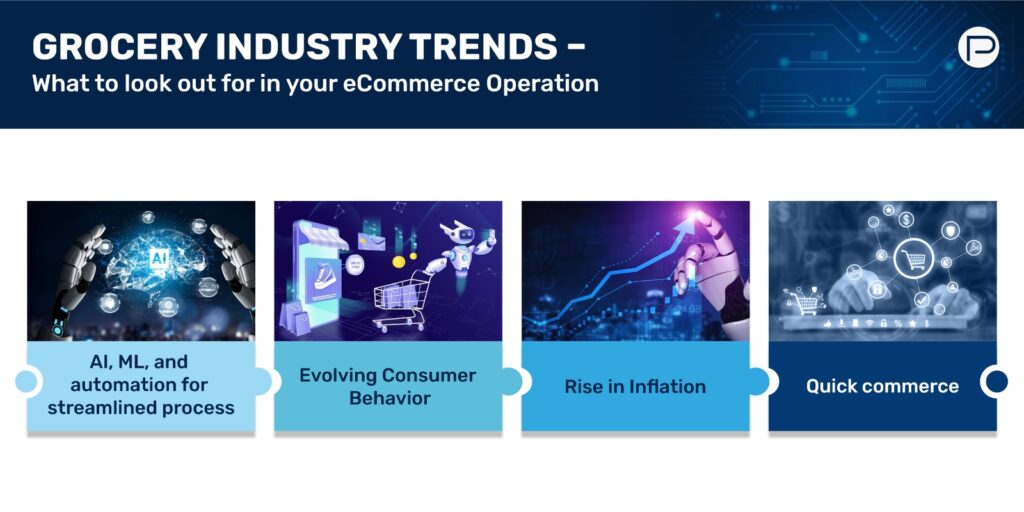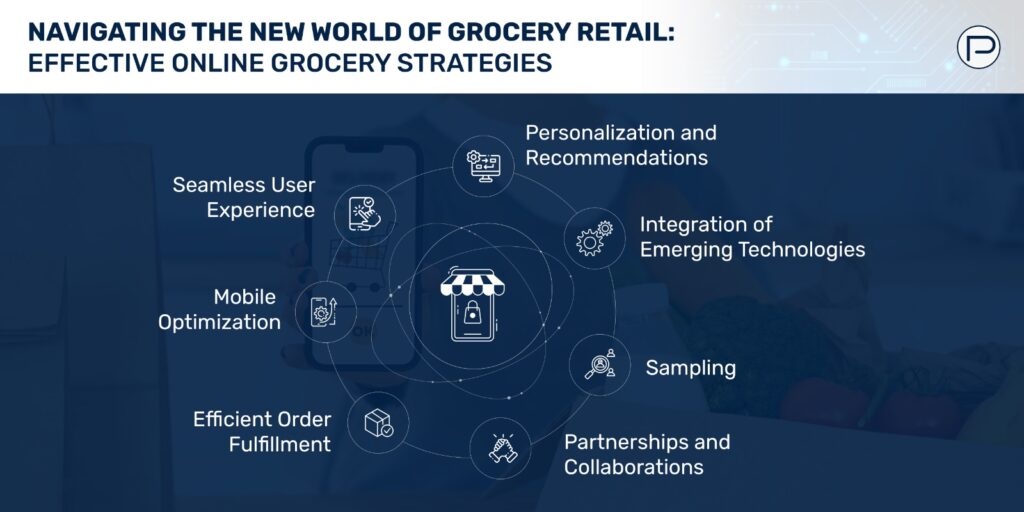The rapid advancement of technology has revolutionized the way we shop, and the grocery industry is no exception. Grocery e-commerce has witnessed a significant surge in recent years, especially in light of the global pandemic. As more and more consumers embrace the convenience and flexibility of online grocery shopping, businesses are seeking innovative growth strategies to stay ahead in this evolving landscape. In this blog, we will explore the growth strategies adopted by grocery e-commerce platforms in the new age.
Table of Contents
E-grocery industry trends – what to look out for in your e-commerce operation
AI, ML, and Automation for Streamlined Process-
Grocers stand to benefit from increased efficiency in a variety of areas, including customer service, quality assurance, managing inventory, and prices. AI data analytics help grocers understand buyers’ choices, and motives for purchasing, leading to more precise pricing and promotions. Retailers can use AI algorithms to analyze data and determine profitable prices for grocery items through “dynamic pricing”.
Evolving Consumer Behavior-
The online platform has expanded its reach to include new customer segments. Younger consumers are playing a significant role in the growth of the e-commerce market. Following are the values they seek from brands these days-
Personalization: It empowers to interact with brands. Social media marketing and personalization enhance conversion rates by offering a more personalized, connected experience for specific age groups.
Value: The new generation is conscious about the prices of products, thus comparing the prices and weights of various products to ensure they are getting the most favorable deal. Approximately 30% of individuals in these age groups are also inclined to browse through flyers and utilize coupons as a means of saving money. EGrocery platforms have introduced subscription models with regular discounts on frequently purchased items. This fits with what buyers want, which is shopping that is quick and saves them money over time.
Rise in Inflation-
Due to the significant increase in inflation, customers are beginning to adopt a more cautious approach to their spending.
Since grocery shopping is an essential aspect of life, it cannot be completely eliminated by anyone. However, customers may be seeking more affordable alternatives and potentially considering purchasing items in larger quantities.
Q-commerce-
Quick commerce is expected to keep growing in 2023. Q-commerce is the rapid delivery of essential goods, like groceries, in a very short time, often within minutes. E-grocery platforms can invest in hyperlocal delivery networks and on-demand services to meet the needs of customers who value convenience and immediate satisfaction. Swiggy a top food delivery platform in India, is expanding into Q-commerce through its “Swiggy Stores” service. Swiggy Stores provides fast delivery of groceries, medicines, and everyday essentials in addition to food.
Navigating the New World of Grocery Retail: Effective Online Grocery Strategies
Having a well-developed online grocery strategy is crucial for achieving success in the evolving landscape of grocery retail. Here are the key strategies you should consider-
1. Seamless User Experience:
To thrive in the online grocery market, businesses must prioritize a seamless user experience. This involves designing user-friendly interfaces, improving website performance, and ensuring seamless navigation. Intuitive search, personalized recommendations for products, and user-friendly shopping carts are key features for a positive user experience.
2. Mobile Optimization:
Mobile optimization is crucial for grocery e-commerce platforms due to the rising usage of smartphones. Providing a dedicated mobile app or responsive website design enables customers to easily shop for groceries at their convenience, regardless of time and place. Mobile apps can use push notifications, location-based offers, and easy reordering to improve customer engagement and retention.
3. Efficient Order Fulfillment:
Timely and efficient order fulfillment is essential to gain customer trust and loyalty. Implementing robust inventory management systems, optimizing warehouse operations, and streamlining logistics are crucial aspects of ensuring smooth order fulfillment. Utilizing advanced technologies like RFID tags, automated picking systems, and real-time inventory tracking can improve accuracy, reduce errors, and enhance overall efficiency.
4. Personalization and Recommendations:
The implementation of personalization strategies significantly contributes to the improvement of customer satisfaction levels and the promotion of repeat purchase behavior. Through the utilization of algorithms and the strategic analysis of customer data, grocery e-commerce platforms have the ability to provide personalized product recommendations that are tailored to individual preferences, purchase history, and browsing behavior. Customized promotions and discount vouchers will help your brand connect with your customers more. For Example-
-Blinkit customizes each user’s homepage depending on their purchasing history, surfing behavior, and preferences. This lets customers rapidly find their favorite products and discover new ones.
-Instamart gives consumers time-sensitive promotions and discounts depending on their buying habits
-BigBasket simplifies the process of reordering frequently purchased items for users. The platform lets users easily add their previous orders to their cart for a smooth shopping experience
5. Integration of Emerging Technologies:
The integration of emerging technologies like artificial intelligence (AI), machine learning (ML), and voice assistants has the potential to completely transform the grocery e-commerce experience. AI-powered chatbots have the capability to offer immediate customer support and assistance. Additionally, ML algorithms can analyze shopping patterns, enabling accurate predictions and optimizing inventory management. Voice assistants such as Amazon’s Alexa or Google Assistant provide customers with the ability to place orders easily, enhancing the convenience of the process. Blinkit has successfully implemented AI-powered algorithms to optimize its delivery routes, resulting in reduced delivery times and improved overall efficiency.
6. Partnerships and Collaborations:
Establishing strategic partnerships and collaborations has the potential to significantly impact grocery e-commerce platforms. By collaborating with local supermarkets, farmers, or suppliers, businesses can ensure access to a wider range of products, fresher produce, and faster delivery options. Collaborating with last-mile delivery providers or courier services can enhance logistics efficiency and provide prompt delivery to customers. Amazon Fresh is integrated with Amazon Prime, offering Prime members free and faster delivery on eligible grocery orders. The collaboration between Amazon Fresh and Amazon Prime encourages customers to use the e-grocery platform and helps retain Prime memberships.
7. Sampling:
Free product samples are a common way for companies to get their products into the hands of consumers. Consumers enjoy the free item, and businesses benefit from the uptick in sales that results from the promotion. Offering free samples of your items to potential customers is a great way to increase sales for online grocery stores. Blinkit provides seasonal sampling campaigns to customers, offering them samples of trending and in-season products. For instance, during holidays, customers can receive samples of festive snacks. Tesco’s online platform offers free sample redemption with minimal purchases, encouraging shoppers to try new goods. Product sampling has two methods:
-Indirect product sampling involves no client contact. i.e., giving customers free samples with your other product purchases.
-Direct product sampling is the opposite. You build and maintain customer relationships, sending free samples home.
Conclusion:
Grocery e-commerce has emerged as a thriving sector in the new age of digital transformation. To capitalize on the growing demand, grocery e-commerce platforms must adopt effective growth strategies. By prioritizing seamless user experiences, mobile optimization, efficient order fulfillment, personalization, integration of emerging technologies, partnerships, and sustainable practices, businesses can position themselves as leaders in this competitive market. The key lies in understanding customer needs and preferences, embracing innovation, and continually evolving to meet the demands of the new-age grocery shopper.
Paxcom leverages its expertise to assist leading grocery brands in achieving exceptional growth through multichannel and omnichannel strategies. Discover how our solutions can help you increase your eCommerce business and optimize your online grocery strategy.
















